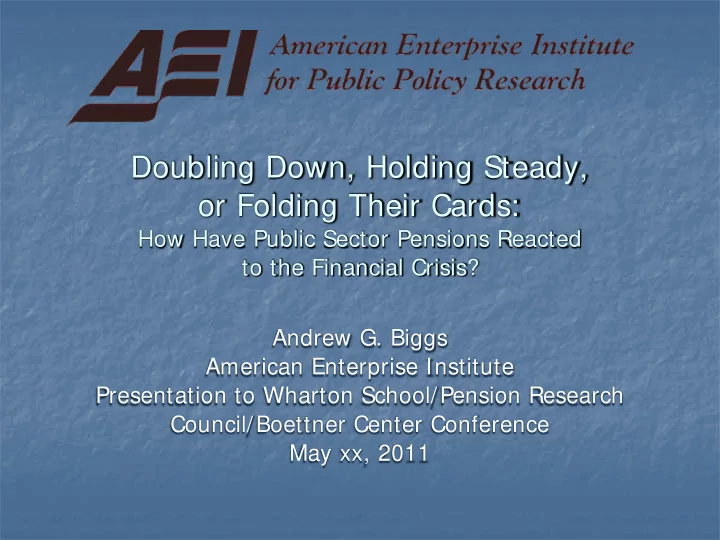

Doubling Down, Holding Steady, or Folding Their Cards: How Have Public Sector Pensions Reacted to the Financial Crisis? Andrew G. Biggs American Enterprise Institute Presentation to Wharton School/Pension Research Council/Boettner Center Conference May xx, 2011
Investments and liabilities Liabilities discounted at expected return on portfolio Higher returns/higher risk means “better funded” Plans already underfunded, projected returns lower Wilshire: Avg 2010 portfolio return 1.3% less than 2007 projections But, expected return often set by legislature Cutting return would have huge effect on funding Plans arrange portfolio to achieve expected return
How have plans reacted? Double down Make up for 2007 losses and/or maintain current discount rate by taking more risk Folding cards Chastened by 2007 losses, cut back on risk, think about asset-liability management, etc. Hold steady Keep on truckin’
Lower projected returns
Which portfolio? Current portfolios Mean assumed return rose from 7.91% in 2007 to 7.94% in 2009 Real returns up by 0.06% More detail, but changes based on market swings Target portfolio Less detail; only broad asset classes But shows plans intent regarding asset allocation and market risk
Sample 30 large public sector pension plans Assets equal to ~ 50% of total pension funds under management Target portfolios obtained from plan CAFRs for 2007 and 2010
Basic approach Tabulate target portfolios for 2007 and 2010 Equities; bonds; alternatives; real estate; cash. Use simplified Wilshire projected returns, risk and covariations to estimate portfolio risk Note: Use Wilshire’s 2010 covariation matrix for both years Compare estimated standard deviation of target portfolio returns for 2007 to 2010
Assumptions Caveats: Due to limited detail of target asset allocations, matrix combines classes, e.g., US and foreign equities; U.S. and foreign bonds; private equity class includes hedge funds.
How risk changed
Results Mean standard deviation 2007: 12.2%; 2010: 12.7% 14 increased risk > 0.3%; 5 reduced; 11 unchanged Largest increase: 2.6% (S. Carolina/Illinois Teachers) Largest reduction: 0.8% (CalSTRS) Mean return (using 2010 returns) 2007: 6.35%; 2010: 6.51% 6.5% return would increase ARCs by around 67% vs. 8% return
Conclusions Plans have increased risk on average Most plans held reasonably steady Small number may be “doubling down” Very few have shifted back Further research Compare to earlier period (e.g., 2001) More detailed analysis by asset class What pensions themselves should do Disclose risk of investments!
Recommend
More recommend